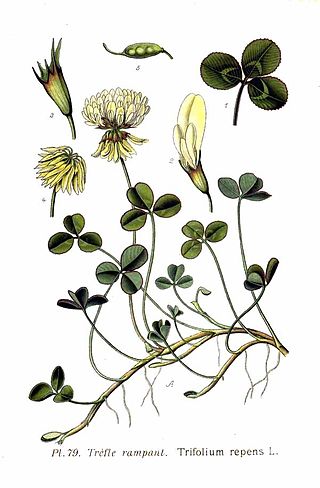
Clovers, also called trefoils, are plants of the genus Trifolium, consisting of about 300 species of flowering plants in the legume family Fabaceae originating in Europe. The genus has a cosmopolitan distribution with the highest diversity in the temperate Northern Hemisphere, but many species also occur in South America and Africa, including at high altitudes on mountains in the tropics.

Trifolium repens, the white clover, is a herbaceous perennial plant in the bean family Fabaceae. It is native to Europe, including the British Isles, and central Asia and is one of the most widely cultivated types of clover. It has been widely introduced worldwide as a forage crop, and is now also common in most grassy areas of North America, Australia and New Zealand. The species includes varieties often classed as small, intermediate and large, according to height, which reflects petiole length. The term 'white clover' is applied to the species in general, 'Dutch clover' is often applied to intermediate varieties, and 'ladino clover' is applied to large varieties.

Trifolium stoloniferum, the running buffalo clover, is an endangered species of perennial clover native to the eastern and midwestern United States. From 1940 to 1983 it was believed to be extinct until two populations were discovered in West Virginia. Since then, more populations have been found in the US but it still remains one of the most imperiled plants in North America.

Trifolium pratense, red clover, is a herbaceous species of flowering plant in the bean family, Fabaceae. It is native to the Old World, but planted and naturalised in many other regions.
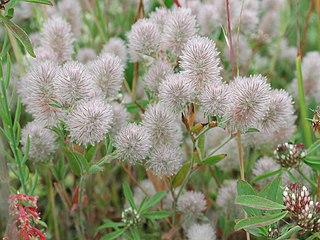
Trifolium arvense, commonly known as the hare's-foot clover, rabbitfoot clover, stone clover or oldfield clover, is a flowering plant in the bean family Fabaceae. This species of clover is native to most of Europe, excluding the Arctic zone, and western Asia, in plain or mid-mountain habitats up to 1,600 metres (5,200 ft) altitude. It grows in dry sandy soils, both acidic and alkaline, soil with dry-mesic conditions and is typically found at the edge of fields, in wastelands, at the side of roads, on sand dunes, and opportunistically in vineyards and orchards when they are not irrigated.

Trifolium campestre, commonly known as hop trefoil, field clover and low hop clover, is a species of flowering plant native to Europe and western Asia, growing in dry, sandy grassland habitats, fields, woodland margins, roadsides, wastelands and cultivated land. The species name campestre means "of the fields".

Medicago lupulina, commonly known as black medick, nonesuch, or hop clover, is a plant of dry grassland belonging to the legume or clover family. Plants of the genus Medicago, or bur clovers, are closely related to the true clovers (Trifolium) and sweet clover (Melilotus). Like the true clovers, black medick has three leaflets and a small, yellow flower closely resembling those of lesser trefoil. Black medick belongs to the same genus as alfalfa.

Trifolium alexandrinum is an annual clover cultivated mostly in irrigated sub-tropical regions, and used as leguminous crop. It is an important winter crop in Egypt, where it may have been cultivated since ancient times, and was introduced into northern India in the early nineteenth century. It is also grown in the United States, Europe, China and Australia.
Trifolium beckwithii is a species of clover known by the common name Beckwith's clover.
Trifolium breweri, which has the common names forest clover and Brewer's clover, is a perennial clover that is native to mixed evergreen forests and coastal coniferous forests in Southern Oregon and California.

Trifolium fucatum is a species of clover known by the common names bull clover and sour clover. It is native to the western United States, where it grows in many types of habitat, becoming common to abundant in some areas. It is an edible species of clover.
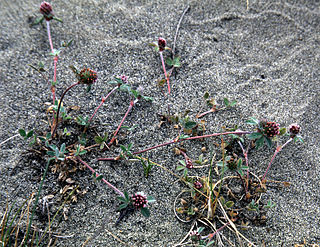
Trifolium macraei is a species of clover known by the common names Chilean clover, double-head clover, and MacRae's clover. It has a disjunct distribution, occurring on the coastline of Oregon and California in the United States, as well as in South America. It grows in coastal habitat, such as sand dunes, and disturbed areas. It is an annual herb taking a decumbent or erect form. The leaves are made up of oval leaflets 1 to 2 centimeters in length. The inflorescence is usually made up of two oval or rounded heads of flowers each measuring up to 1.5 centimeters wide. Each flower has a calyx of sepals which taper into densely hairy bristles. The flower corolla is purple or bicolored with white or pink.

Trifolium macrocephalum is a species of clover known by the common name largehead clover or bighead clover native to the Great Basin region of the western United States.

Trifolium obtusiflorum is a species of clover known by the common name clammy clover. It is native to California in the Peninsular, Transverse, Sierra Nevada, and the California Coast Ranges and Cascade Range into southwestern Oregon.
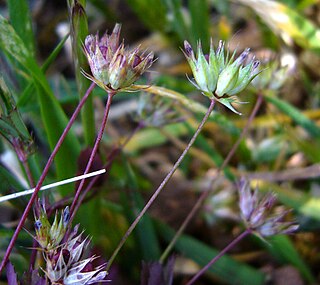
Trifolium oliganthum is a species of clover known by the common name fewflower clover. It is native to western coastal and montane North America from British Columbia to California, the Sierra Nevada, and to Baja California, where it occurs in many types of habitat.

Trifolium variegatum is a species of clover known by the common name whitetip clover. It is native to western North America from southern Alaska and British Columbia to Baja California, where it occurs in many types of habitat.
Mentzelia packardiae is a species of flowering plant in the Loasaceae known by the common names Packard's blazingstar and Packard's stickleaf. It is native to the western United States, where it is known from a small area in Oregon and Nevada.
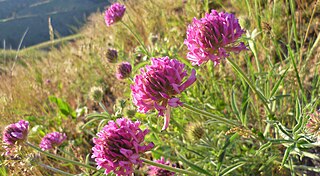
Trifolium thompsonii is a species of flowering plant in the legume family known by the common name Thompson's clover. It is endemic to Washington state in the United States, where it occurs in two counties. One of the largest populations occurs in the Entiat Slopes Natural Area Preserve in Chelan County.

Trifolium friscanum is a rare species of flowering plant in the legume family known by the common name Frisco clover. It is endemic to the US state of Utah, where it is known only from Beaver and Millard Counties. It is found growing on the San Francisco Mountains, Beaver Lake Mountains, Wah Wah Mountains and Tunnel Springs Mountains. Most individuals live in the San Francisco Mountains, where the highest point is called Frisco Peak. It was originally described as a variety of Trifolium andersonii in 1978, but was elevated to species status in 1993. It occurs over 250 km (160 mi) away from the nearest T. andersonii.
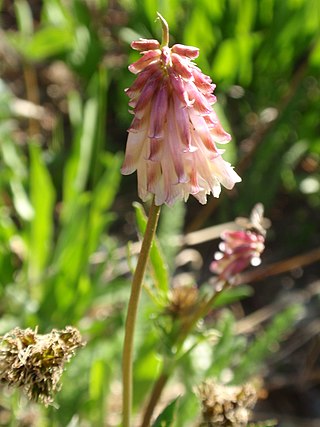
Trifolium kingii, the King's clover, is a perennial clover in the legume family (Fabaceae)

















